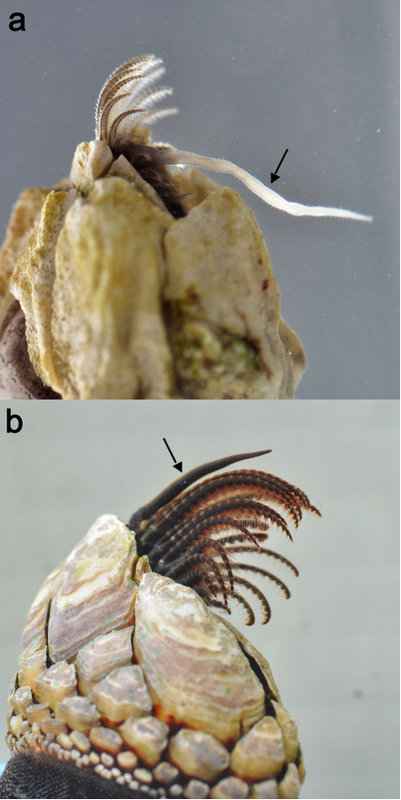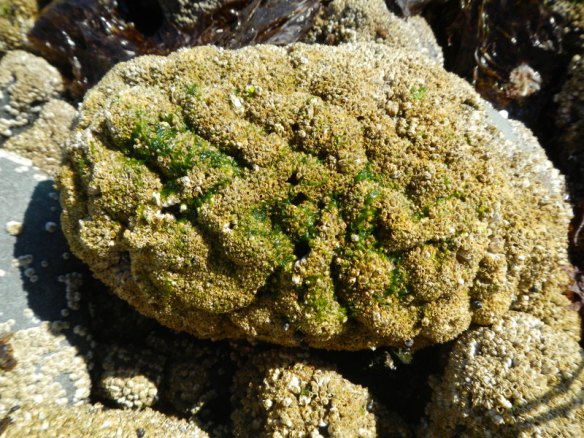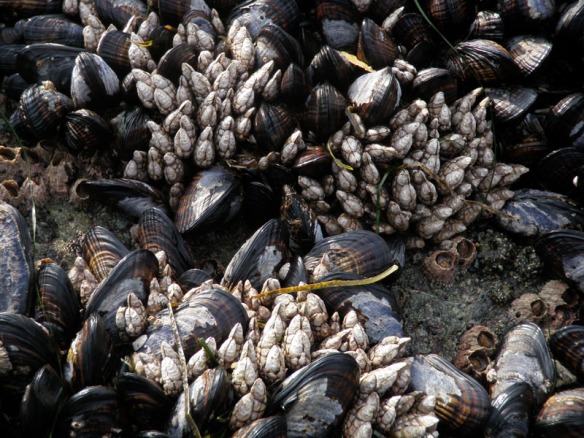By Marjan Barazandeh
Whenever you go to intertidal shores in almost any island in Barkley Sound, you will find hundreds of calcareous shells, ranging from less than 1 cm to 10 cm, attached to the surface, on bare rocks or on mussel beds. Believe it or not, they are not mollusks! They are barnacles, a group of crustaceans that have amazed evolutionary biologists, including Darwin, for more than 150 years.
The typical and most familiar barnacles are acorn barnacles. They usually have 6 fixed calcareous plates surrounding their body that are permanently cemented to the substrata and 2 pairs of moveable plates at the top (Fig 1).

Fig1. Different species of acorn barnacles: Semibalanus cariosus (the largest ones), Balanus glandula (the white-yellow smaller ones) and Chthamalus dalli (the brown smallest ones). Credit: M. Barazandeh
The gooseneck (stalked) barnacles are the less familiar group. They attach to the substrata by a long fleshy stalk and the two valves, usually made of 5 plates, are at the top of the stalk (Fig 2). I have never tried them, but there are a lot of people who eat stalked barnacles and claim they are delicious.

Fig 2. Clump of Pollicipes polymerus, a gooseneck barnacle. Credit: A.R. Palmer
The organisms inside the shells are shrimp-like animals, which lie on their back, with the head attached to the bottom surface, and grab food from the water using their feathery legs. Except for a few species, most barnacles are hermaphrodites, so they are able to act as both males and females.
Well, there are many cool facts about barnacles, but the most famous one is perhaps their long penises, which in some species could extend up to eight times their body length. You can imagine how advantageous this would be to sessile organisms. They can copulate with several neighbors and release their sperm into their mantle cavity. But is that true for all types of barnacles?
Pollicipes polymerus is an intertidal gooseneck barnacle with a relatively short penis, which is less than their body length, even when extended (Fig 3). It’s not a disaster for this species since they are usually found in tight clumps (Fig 2).

Fig 3. a) Balanus glandula penis length versus b) Pollicipes polymerus penis length. Credit: C.J. Neufeld
But what about those individuals that don’t have any neighbors in their penis range? How sad their love life would be! Well, some species have overcome this problem by self-fertilization; however, P. polymerus is presumed incapable of self fertilization. Yet, there are several isolated individuals that have fertilized egg masses (Fig 4). How did they get fertilized? That was the initial motivation to my study. The first possibility: maybe, they are able to self-fertilize!

Fig 4. Pollicipes polymerus, an isolated individual (left) and an isolated pair (right). Credit: A.R. Palmer
On the other hand, by doing a close survey in the field, we found a lot of P. polymerus leaking some white liquid out of their opercular plates at low tide (Fig 5). Is that the sperm? If it is, then what would be the fate of it? Could that be captured by other individuals? Nobody has ever suggested this could happen in any crustacean.

Fig 5. Pollicipes polymerus leaking sperm at low tide. Credit: M. Barazandeh
That’s when my supervisor (Rich Palmer), my ex-labmate (Chris Neufeld) and I went out to a few beautiful islands in Barkley Sound and collected as many isolated fertilized individuals as we could (Fig 6). We also collected some isolated pairs, where there were two adjacent individuals, not having any other barnacles around, and at least one of them was fertilized.

Fig 6. Chris and I, Seppings Island, August 2009. Credit: A.R. Palmer
I brought them back to the UofA, where I had access to all molecular tools I needed and to the experts that could help me with developing genetic markers for my species, Dave Coltman and Corey Davis. The plan was genotyping both the adults and the egg masses to see if there are any alleles in the egg masses that are not present in the adults. Those must have been obtained from water.
I spent more than a year developing microsatellites for P. polymerus without any success (sigh…). Then I switched to Single Nucleotide Polymorphisms (SNP). I developed 16 SNPs and got whatever I needed in a month! I don’t regret the time I spent on microsatellites because I learned a lot during the troubleshooting process and I’m pretty sure I can use all those experiences some time in the future.
So, the results were fascinating or as Rich Palmer says: “Darwin would be thrilled by this!” All of the egg masses of isolated individuals had at least one allele, not present in the parent. Even in isolated pairs, there were alleles that belonged to neither of the two adults. So, that’s official! They are able to spermcast! It doesn’t mean that they don’t copulate, but at least we now know that they also capture sperm from the water. This is the first example of spermcast mating in aquatic arthropods, which makes us re-think barnacles’ reproductive biology and all the previous reports on self-fertilization in barnacles. This could also have a major impact on previous barnacle population studies that assumed no spermcast mating!
Our results were just published last week (Jan 16, 2013) in Proceeding of the Royal Society B: Biological Sciences (http://dx.doi.org/10.1098/rspb.2012.2919) and surprisingly, we received a lot of media attention about that paper. We were bombarded with emails asking questions and requests for interviews. Honestly, I wasn’t expecting this at all. Like most of other projects, there were lots of disappointing moments during this study, but at the end it was worth all the effort we made. We have a web page for this study, including the media coverage and some of the brilliant headlines used in articles: http://www.biology.ualberta.ca/palmer/pubs/13PRSL/13PRSL.htm
So, the take-home message is we should always be curious about what we observe and have the courage to question the old beliefs.














